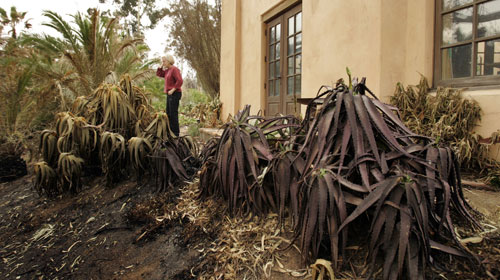Being a Southern California resident I witnessed first hand the destruction of the recent fires that surrounded the area. Also being a designer I was surprised to learn about the benefits of succulents in a fire retardent application written in the LA times. Enjoy.
 SUCCULENTS have soared in popularity recently because they're drought-tolerant, easy-care and just plain cool to look at, and now there's another compelling reason to grow them: They're fire-retardant. During last month's wildfires, succulents -- which by definition store water in plump leaves and stems -- apparently stopped a blaze in its tracks.
SUCCULENTS have soared in popularity recently because they're drought-tolerant, easy-care and just plain cool to look at, and now there's another compelling reason to grow them: They're fire-retardant. During last month's wildfires, succulents -- which by definition store water in plump leaves and stems -- apparently stopped a blaze in its tracks.
"Succulents saved our home!" Suzy and Rob Schaefer wrote in a jubilant e-mail to friends and family after they returned to their fire-ravaged neighborhood in Rancho Santa Fe. The tabloidian statement is out of character for the low-key couple -- he's retired and she's an artist -- but it seems justified.
Their garden of aloes, agaves, euphorbias and more -- created by Suzy with the help of San Diego landscape architect Robert Dean -- encircles the Southwest-style home, which is adjacent to a palm- and eucalyptus-filled canyon. The garden is intact, but many of the canyon's trees are blackened skeletons.
A tentacle of the Witch Creek fire, driven by high winds, roared down the canyon, which runs along the edge of the Schaefers' back yard.
"Flames came within 6 feet of the house, then stopped," Suzy says.
Shielding the most vulnerable corner of their home is a common, unassuming succulent that is common yet has no common name: Aloe arborescens. As it held off the flames, its fleshy leaves cooked and turned the color of putty.
Aloe arborescens, native to South Africa, grows throughout Southern California; dense plantings of it rim the cliffs of coastal communities. Its tapered green leaves are serrated on the edges, but not sharp, and radiate from a central stem, forming starfish-like rosettes. These overlap into mounding plants that grow 5 or 6 feet high, and as wide. In midwinter, the plants send up brilliant orange flower spikes that, ironically, often are described as "torchlike."
Wildfires are opportunistic; they focus on easy fodder, in this case the canyon's dry leaves and wispy fronds. Flames from the canyon lapped at the Schaefer garden, which sits just beyond the bank.
Seeking fuel, the fire climbed part way up a eucalyptus; scorched the slope; probed aloes, jade plants and a succulent ground cover; and then retreated. Instead it engulfed and rapidly devoured an older home across the street.
"Succulents may broil or bake, but they don't burst into flames or spread them," says Don Newcomer, owner of Serra Gardens, a succulent specialty nursery that operated in Malibu for 25 years and will soon relocate south to Fallbrook for business reasons. When a wildfire threatened the nursery a decade ago, succulents halted the flames, Newcomer says, saving both his business and his home.
Eddie Villavicencio, deputy fire marshal for the San Diego Fire-Rescue Department, affirms that succulents are fire-retardant, especially jade and cactus. An exception are "certain ice plants, which if not well-maintained can be flammable underneath."
His department, which also monitors erosion control, cautions against planting trailing ground covers such as Hottentot fig (Carpobrotus edulis) atop steep slopes; its moisture-filled leaves are heavy and roots too shallow to hold the soil. (For more resources on fire-wise landscaping, go to latimes.com/home).
Gary Lyons, curator of the desert collection at the Huntington Botanical Gardens in San Marino, is outspoken about his desire to see succulents used as perimeter plantings for homes in areas.
"After the Altadena fire in 1993, I could see that agaves, aloes and opuntia had not burned, but rather had cooked," Lyons recalls. "They can't carry a fire. I wondered why there was no code requirement or law that requires developers and residents to use succulents in high fire areas. Why should taxpayers shoulder the firefighting costs of a hillside development's incendiary landscape?"
Why, indeed. Homeowners adjacent to wild lands may not realize it, but the plants with which they routinely surround their dwellings are infamously flammable (among them, pines, junipers, bougainvillea, flax and grasses). Basically, anything woody and twiggy is a potential haystack, ready to be ignited by the tiniest ember -- especially in autumn, especially during a record-setting drought.
California native plants are wonderfully resilient when it comes to wildfires, but it's not because they don't burn; some of the most common natives such as the aptly named greasewood (Adenostoma fasciculatum) are highly flammable. Fire is part of the chaparral's natural cycle, enabling seeds to burst open and fresh green growth to take the place of old. This makes natives admirable -- ingenious, even -- but not, unless they're fleshy, fire-retardant.
"There is some confusion about the terms 'drought-tolerant,' 'native plants,' and 'fire-retardant plants,' " Lyons explains. "Fire-retardant plants vis-à-vis cactus and succulents stand apart from drought tolerant and natives. A native plant garden in the chaparral is like growing Roman candles. Drought tolerant may not be much better."
"After any brush fire, you'll see succulents that were not burned," agrees Newcomer, who, like Lyons, would like to see homeowner associations and similar groups provide cuttings of Aloe arborescens to residents as a community service. "Aloes may not be native to Southern California, but they're not invasive, either," Newcomer says. "It's not like they escape and invade creek beds." He adds that Aloe arborescens offers the same health benefits of Aloe vera -- these and other "medicinal aloes" contain a viscous gel that purportedly aids the healing of minor burns.
If it seems absurd to legislate the use of succulents as landscape plants, it likely won't be necessary. They're already catching on. According to Ron Vanderhoff, nursery manager of Roger's Gardens in Corona del Mar -- which does the largest volume of sales of any independently owned garden center in the western U.S., "our business in succulents has risen from $40,000 in retail sales four or five years ago to $400,000 a year, and it continues to grow. No other category of plants in our store has shown anything close to this increase. We now do 7% or 8% of our volume in succulents."
The reason has to do with the plants' "simplicity of maintenance," Vanderhoff says. "People are spending less time in their gardens, and succulents are less fussy than annuals and perennials. They also have a lesser need for water and fertilizer, so they're more 'green.' And they're very sculptural and artistic. Succulents provide drama with their structure, leaves, colors . . . they're very expressive plants."
They're also easy to start from cuttings, which is how Suzy Schaefer filled her garden.
"I whack them back and replant them," she says, adding that her garden "is not just a way to cover dirt. It's a living thing, and half the fun is to enjoy it aesthetically. I love the shapes of succulents, and the way they look ordinary and then send up a bloom that knocks your socks off. Growing succulents is like collecting art or sculpture -- better, because when you have too many, you just give them away."
And as for those aloes, it appears their melted leaves protected the plants themselves; the centers of the rosettes are still a vibrant green.
Debra Lee Baldwin is the author of "Designing With Succulents" (Timber Press, 2007). Please send comments to home@latimes.com.
